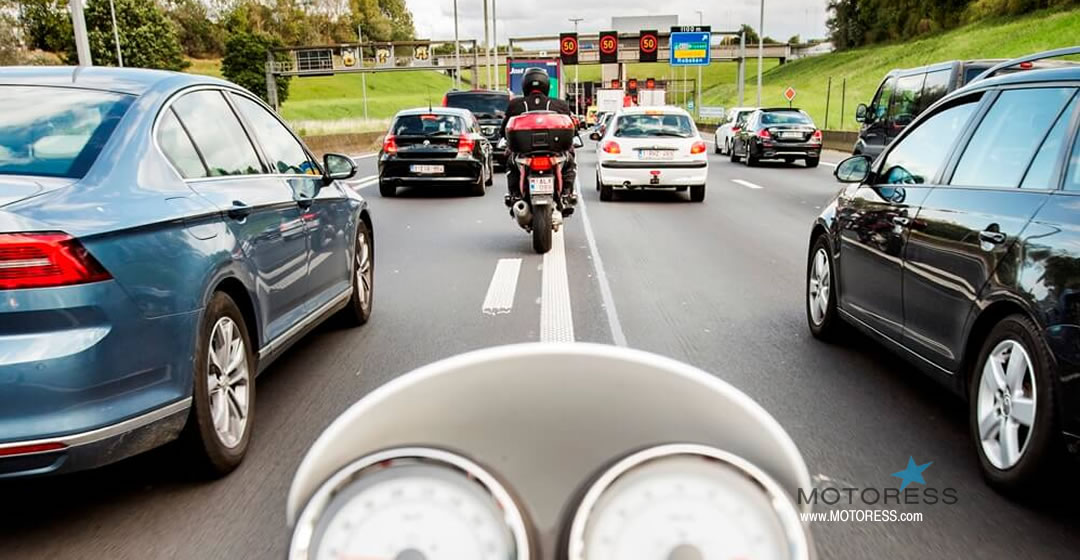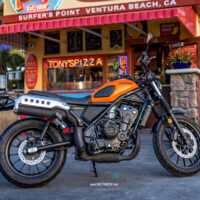Last Update: 18 September 2023

Let’s delve into a subject that often stirs confusion and debate within the motorcycle community – lane splitting and lane filtering. Drawing from my expertise as a motorcycle instructor and rider enthusiast, here I’d like to underline the key differences between these two riding techniques. It’s important to note that in Canada and nearly all of the United States (apart from California, and three other states) – lane splitting is uniformly prohibited. But not so in many other parts of the world where it is safely practised and legal.
Generally, and particularly in Canada however, there is a lack of explicit legislation pertaining to motorcyclists within the framework of driving laws on this topic. This creates confusion and misunderstandings about lane splitting. So, let’s dive in and explore what lane splitting and lane filtering are all about to make things crystal clear.
Lane Splitting
Lane splitting, also known as “white lining” and even “lane filtering” in some regions, is a practice where a motorcyclist rides their bike between lanes of slow-moving or stopped traffic on a multi-lane road. It’s often associated in North America with California – hence the term the “California Roll”, where it’s legal under certain conditions. However, it’s essential to remember that laws vary from place to place, country to country – and in many areas, including Ontario, it’s strictly prohibited.
What Are the Pros of Lane Splitting?
- Reduced Traffic Congestion: One of the key arguments in favour of lane splitting is that it can reduce traffic congestion. By allowing motorcycles to move ahead of cars in slow-moving traffic, it theoretically eases the overall flow of vehicles.
- Reduced Risk of Rear-End Collisions: When done correctly, lane splitting can reduce the risk of a motorcycle being rear-ended by a distracted or inattentive driver in heavy traffic.
The Cons of Lane Splitting
- Safety Concerns: Critics argue that lane splitting can be risky, particularly if riders don’t do it cautiously. Abrupt lane changes, unaware drivers, and narrow spaces can lead to accidents.
- Legal Complexities: The legality of lane splitting varies widely. In Ontario, it’s simply not permitted, which can result in hefty fines and penalties if caught.
Lane Filtering: A Different Approach
Lane filtering is another manoeuvre that often gets confused with lane splitting. However, there’s a notable difference. Lane filtering typically occurs at intersections, where a motorcyclist advances to the front of the line of cars stopped at a red light. This allows the rider to move away from the potentially hazardous cluster of vehicles in the event of a rear-end collision.
The Pros of Lane Filtering
- Safety at Intersections: Lane filtering can significantly enhance a rider’s safety when stopped at intersections. Being in front of traffic reduces the risk of being rear-ended.
- Improved Visibility: Filtering to the front of the line can also improve a motorcyclist’s visibility to other road users, reducing the chance of being overlooked.
The Cons of Lane Filtering
- Legal Restrictions: Just like lane splitting, the legality of lane filtering varies by location. In Ontario, as of my knowledge cutoff in September 2021, lane filtering isn’t legal. It’s essential to check local laws for any updates.
- Rider Responsibility: While lane filtering can be safer at intersections, it still requires responsible riding. Moving to the front of the line should be done cautiously, without excessive speed or recklessness.

Other Facts
News from a study conducted by the Federation of European Motorcyclists’ Associations (FEMA) shows a study was carried out in 11 French departments (France), which are analogous to counties, spanning a five-year duration. The Centre for Studies and Expertise on Risks, Environment, Mobility, and Planning (CEREMA) oversaw the study’s evaluation, with assistance from the Fédération Française des Motards en Colère (French Federation of Angry Bikers) which contributed to the formulation of lane splitting guidelines.
The result? The submitted report reveals a 12 percent increase in motorcycle accidents within the 11 departments over the five-year period, while accidents decreased by 10 percent on roads outside of the test area.
Nevertheless, there are positive aspects to consider. The report also indicates that the study effectively raised awareness of lane splitting amongst car drivers, especially those who had recently undergone training. Drivers generally responded positively to the presence of motorcycles splitting lanes.
Eric Thiollier, a board member of FFMC, expressed a positive perspective on the impact, even though the results did not align with initial expectations:
The behaviour and the safety records improved significantly during the five-year period of the experiment, showing that setting rules had a positive impact, although not enough to be satisfying. The increase in accidents could also be linked to the fact that more powered two-wheelers were lane-splitting.
According to a report by the Sacramento Bee., a 2014 study conducted at UC Berkeley found that motorcycles engaging in lane splitting have a reduced risk of being rear-ended by cars. However, the study also noted that there is a higher likelihood of motorcycles rear-ending cars during this manoeuvre. The study emphasised that the speed difference between the splitting motorcycle and the surrounding car traffic plays a significant role in determining the level of danger. It concluded that riders who practice slow and safe lane splitting are not at a higher risk than they would typically be under normal riding conditions.
Between The Lanes
Call it what you will, lane splitting or filtering – any form of riding in between live lanes of traffic is risky! While both manoeuvres involve moving through traffic, they occur in distinct situations and carry varying degrees of legality depending on your location.
Remember, in Ontario, where I reside and where you might be reading this, neither lane splitting, nor lane filtering is currently legal.
Riding safely and responsibly should always be our top priority. Stay informed about local laws, ride proficiently, and let’s enjoy the open road while respecting the rules of the journey!
Lane Splitting Excerpt via the The Official Ministry of Transportation (MTO) Motorcycle Handbook
In heavy traffic, some motorcycle and moped drivers try “lane splitting” by driving on the line between lanes of traffic. This is extremely dangerous. Do not do it. It puts you too close to other vehicles. Other drivers do not expect a vehicle to be in that space. Just a small movement, such as a vehicle starting to change lanes or a door opening, can cause a collision because there is no place else for you to go.




